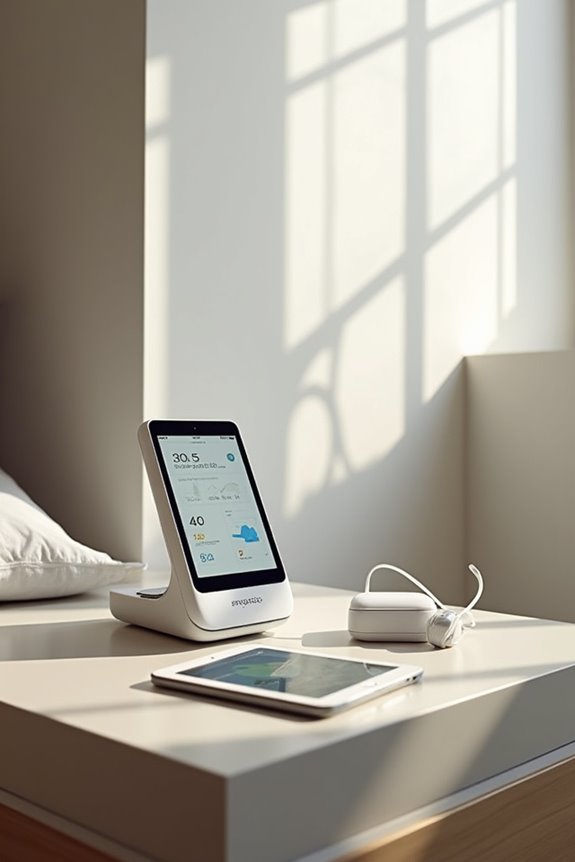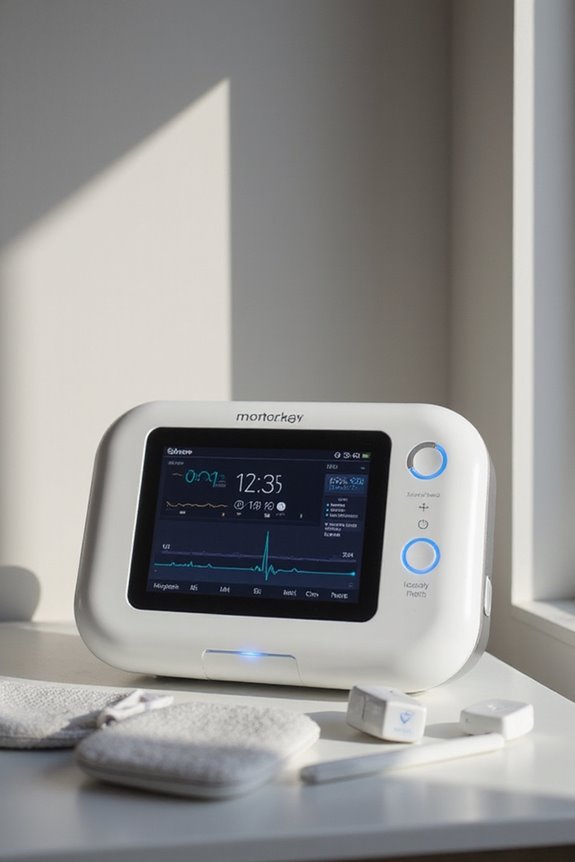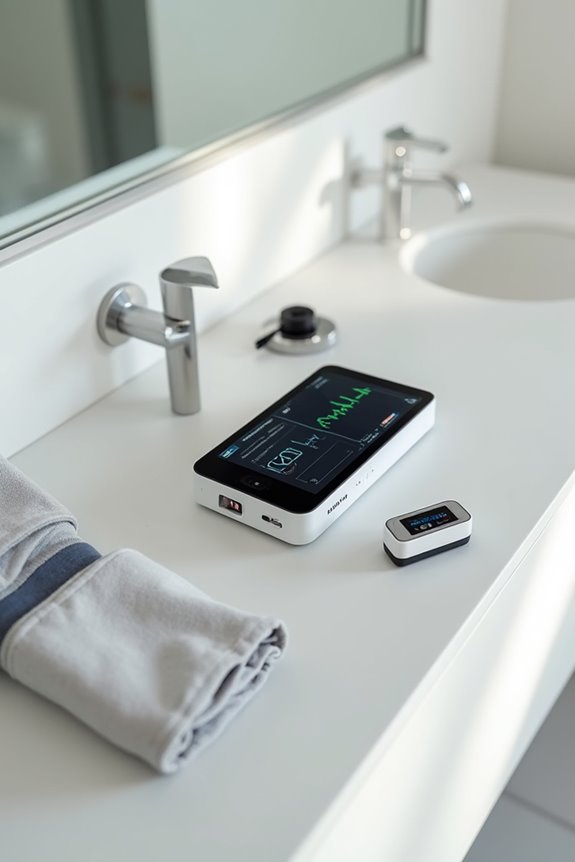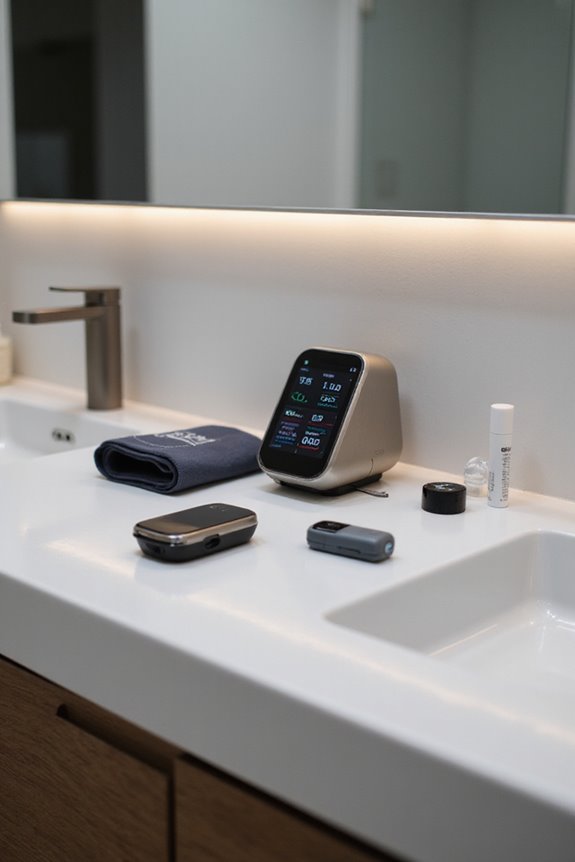Recent innovations in home medical devices have transformed personal health management and care delivery. Key advancements include:
- Wearable Devices: AI-driven wearables enable predictive health insights and real-time monitoring.
- Telehealth Systems: Integration of telehealth services increases patient access, especially in rural areas.
- AI and Machine Learning: These technologies enhance disease detection accuracy, reducing false positives and improving tailored care plans.
With the RPM market projected to grow exponentially, the landscape of home healthcare is rapidly evolving. More insights follow.
Key Takeaways
- AI-driven wearable devices provide predictive insights, enhancing personal health management for early disease detection and proactive interventions.
- Smart clothing with integrated sensors monitors specific health conditions, such as lymphedema and diabetic foot ulcers, in real-time.
- Telehealth integration expands access to healthcare, particularly benefiting rural patients through remote consultations and monitoring.
- Advanced automation and electronic visit verification systems streamline caregiver visits, improving efficiency and reducing administrative tasks.
- The rise of remote patient monitoring (RPM) is projected to significantly grow, with millions of Americans expected to utilize these services by 2025.
Advancements in Wearable Medical Devices
As advancements in wearable medical devices continue to evolve, the integration of technology into personal health management becomes increasingly significant.
Predictive Wearables
- AI-driven devices now offer predictive insights into potential health events.
- Enhanced accuracy through advanced sensors improves data reliability.
Smart Clothing
- Integrated sensors in smart clothing monitor conditions such as lymphedema and diabetic foot ulcers.
- This technology enhances user compliance and comfort with non-invasive monitoring.
Personalization and Integration
- Wearables provide tailored health recommendations, adapting to individual needs.
- Seamless connectivity with other devices creates a thorough health ecosystem.
The continuous development of these devices empowers individuals to proactively manage their health, leading to improved outcomes through real-time feedback and early disease detection.
Home Healthcare Systems Revolution

The home healthcare systems revolution is fundamentally transforming the landscape of patient care, utilizing advanced technologies to enhance service delivery and improve health outcomes.
Key components include:
- Telehealth Integration: Increasing access to care, especially for rural patients, enabling remote consultations and continuous health monitoring.
- Automation and EVV Systems: Streamlining caregiver visits and ensuring regulatory compliance, reducing administrative burdens, and enhancing transparency.
- Personalized Interventions: Utilizing patient-specific data to create tailored care plans, improving patient engagement and outcomes through predictive analytics.
- Workforce Management Technologies: Addressing labor shortages, monitoring caregiver burnout, and enhancing coordination among care teams.
These innovations foster a connected healthcare environment, promoting efficiency and improving patient satisfaction in home healthcare settings. Additionally, the incorporation of emergency response systems ensures that patients receive immediate assistance in critical situations, further enhancing safety and care in the home.
The Role of AI and Machine Learning

AI and machine learning are increasingly crucial in enhancing home medical devices, markedly impacting patient care.
AI Diagnostics
- AI algorithms analyze extensive datasets, improving early disease detection rates.
- They reduce false positives and negatives, increasing at-home health assessment reliability.
Machine Learning Personalization
- Machine learning models adapt diagnostics to individual patient data trends over time.
- Continuous monitoring facilitates real-time anomaly detection, enabling timely clinical interventions.
Remote Patient Monitoring
- AI processes data from wearables for continuous tracking of critical signs and chronic conditions.
- Predictive analytics forecast health deterioration, allowing preemptive medical responses.
Incorporating AI enhances the efficiency and effectiveness of home healthcare, creating a supportive environment for patients and caregivers alike.
Innovative Startups Shaping Home Healthcare

Innovative startups are redefining home healthcare by leveraging technology to enhance patient care and accessibility. These companies focus on integrating advanced sensors and AI into miniaturized devices, facilitating continuous health monitoring for older adults.
Key players in this sector include:
- Carbon Health: Extensive health service management platform.
- Arise: Virtual support for individuals with eating disorders.
- Spring Health: Tailored mental health care plans to minimize trial-and-error treatments.
- Practo: Connects patients with healthcare providers through online services.
- HaloDoc: Telemedicine services, including consultations and medicine delivery.
These startup innovations are not only user-friendly and cost-effective but also seamlessly integrate with smart home technologies, fostering a more accessible and efficient home healthcare environment.
Trends in Telehealth and Remote Monitoring

Recent advancements in technology have markedly influenced the landscape of telehealth and remote monitoring (RPM).
- The RPM market is projected to grow by 128% globally by 2027, with over 71 million Americans expected to utilize these services by 2025.
- Valued at approximately $14 billion in 2023, the U.S. RPM market is forecasted to reach $29 billion by 2030.
- Primary care clinicians deliver 48% of RPM services, mainly in physician offices.
- Telehealth integration continues to rise, with high satisfaction reported among patients and providers.
- Despite challenges in access, especially in rural areas, the shift towards virtual care could potentially virtualize 80-90% of outpatient visits, highlighting the importance of RPM in chronic disease management.
Frequently Asked Questions
How Do Home Medical Devices Ensure Patient Data Privacy and Security?
Patient data privacy and security greatly stem from strict safeguards. Smart solutions like data encryption and patient consent cultivate trust, ensuring sensitive information remains secure while fostering a sense of belonging within the healthcare community.
What Are the Costs Associated With Home Medical Devices?
Costs associated with home medical devices involve initial purchase prices, ongoing maintenance, and potential upgrades. Cost comparisons reveal significant variations, while insurance coverage can alleviate expenses, fostering a sense of belonging within the health-focused community.
Can Home Medical Devices Be Used for All Age Groups?
Home medical devices, thoughtfully designed with age adaptability, cater to diverse users. Their usability across all age groups fosters inclusivity, ensuring everyone feels supported in their healthcare journey, regardless of physical capabilities or environmental constraints.
What Is the Lifespan of Typical Home Medical Devices?
The lifespan of typical home medical devices varies considerably, generally ranging from three to over fifteen years. Device durability is influenced by maintenance requirements, usage frequency, and technological advancements, ultimately affecting their longevity and reliability.
How Do I Choose the Right Home Medical Device for My Needs?
Choosing the right home medical device involves evaluating device compatibility with health needs and reviewing user feedback. This guarantees a supportive choice, fostering a sense of belonging while prioritizing safety, usability, and effective healthcare management.



